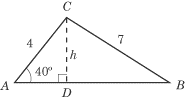3.C
The kite-flying situation can be modeled by a right triangle with an acute angle
of 55º, and a leg opposite that angle whose length is 100 feet. Once you picture
the situation as a right triangle, you can see that
=100.gif)
where the hypotenuse is the length of the kite string. Therefore, letting x
represent the hypotenuse:
.gif)
4.B
Simplify the left side using trigonometric identities to make this problem
easier to solve. First, you need to rearrange the identity sin2 x
+ cos2 x = 1 so that you find cos2 x – 1 =
–sin2 x. Then substitute this into the equation. Later,
substitute tan x for sin x/cos x.
-1-cos2(x).gif)
Now solve the equation tan x = 1. It’s just a matter of taking the
inverse of both sides of the equation:< x = arctan 1 = 45º.
5.B
If ? = 1/4 ?, we can rewrite the given conditions: sin
? and cos 4 ? are greater than zero. These are the conditions we must meet.
In order for sin a to be greater than zero, 0º <
? < 180º, because sine is only positive in the first two quadrants. This mean 0 <
4 ? < 720º. Cosine, however, is positive only in the first and fourth quadrants.
Thus, for 0º < x < 720º, cosine is only positive in the following
intervals: (0º, 90º), (270º, 450º), and (630º, 720º). By dividing these
intervals by four, the range of ? is defined: 0º < ? < 22.5º, 67.5º <
? < 112.5º, or 157.5º < ? < 180º. The only answer choice that does not fall within one of these intervals
is 65º.
6.C
The variable b adjusts the period of the standard function from 2p to
2p /b. The standard sine function, y = sin
x, crosses the x-axis three times in the interval 0 = x =
2p: at 0, p, and 2p. So, since the period of a function is the interval between
each repeat of the function’s curve, the only way for the graph of y = 3
sin bx to cross the x-axis more often than y = sin x
is to have a shorter period. Thus, b must be greater than 1.
To make the function cross the x-axis
7/3 as many times as y = sin x does,
you might be tempted to make the period
3 /7 as long as 2p, which would correspond to a
b value of 7/3. This, however, is wrong, because it counts the
intersection at 2p too many times. You can check this result if you have a
graphing calculator.
By halving the period of the function, you might think that the number of
crossings would double. Actually, y = sin 2x crosses the x-axis
only five times because the crossing at 2p does not figure into the doubling.
Using this logic as a guide, you see that to achieve seven crossings, you must
make the period 3 times shorter so that the first 2 crossings are tripled in
number and the crossing at 2p is added at the end. This means that the period of
the unknown function is
2p/3, and b = 3.
7.A
In the cosine function, the amplitude is the coefficient in front of cosine and
the period is 2p divided by the coefficient of x. So for the function
y = 2 cos (4x + 2) – 7, the amplitude is 2 and the period is 2p/4
= p/2.
8.B
This problem takes a few steps. Your goal is to find AB and the height to
vertex C. Then you can use the area formula, A = 1/2
bh, where
bis the base and
his the height.
First, draw an altitude from C to AB.

The length of this altitude is the height of the triangle. In the triangle you
just formed, triangle ACD, sin 40º = h/4.
So, h= 4 sin 40º ˜ 2.57. The
Pythagorean theorem can now be used to find lengths AD and BD:

The sum of AD and BD is AB, approximately 9.58. Finally,
you can plug these values back into the area formula:
.gif) Back
Next
Back
Next
Next to display next topic in the chapter.
Mathematics Practice Questions
Video Lessons and 10 Fully Explained Grand Tests
Large number of solved practice MCQ with explanations. Video Lessons and 10 Fully explained Grand/Full Tests.